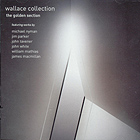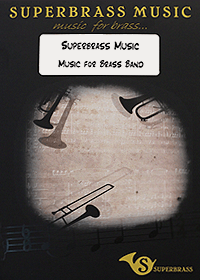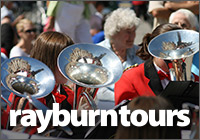 The Golden Section
The Golden Section
25-Apr-2002
The Wallace Collection
Featuring works by: Michael Nyman, Jim Parker, John Taverner, John White, William Matthias and James Macmillan
LINN Recordings: CD CKD092
Playing Time: 72.05
John Wallace is no stranger to the brass band world; but for the most part he has kept a respectful distance to his musical relationship with us. He is an internationally acclaimed virtuoso performer, a respected academic and a champion of cutting edge brass repertoire, yet for the most part he is seen by the banding movement as being in the same mould as another "stranger" – one Elgar Howarth.
We are a very parochial lot in the banding movement and musical "outsiders" are viewed with a suspicion that can never quite be overcome. It doesn't matter how good, how clever, how inspired or even how popular they are, the likes of Howarth and Wallace are never, as Mrs Thatcher so memorably stated, "One of Us".
This a major personality fault on our behalf and one that has robbed us of talents so diverse and spectacular that we have remained the poorer for it for far too many years. Thatcher got it all wrong as so have we, for these musicians should have been the driving force of the development of the brass band into the 21st century. We could have been playing works by Macmillan, Taverner, Nyman and Parker at the Albert Hall and British Open. Instead we got Les Preludes and Concerto for Brass Band. Makes you think eh?
"The Golden Section" combines a series of works from these exotic composers that gives plenty of food for thought and leaves you with the undoubted impression that the banding world has lost out for not pursuing them to write more for us.
Although these works are for brass quintet (and what a quintet they are: John Wallace and John Miller on trumpet, Paul Gardham on horn, Simon Gunton on trombone and Robin Haggart on tuba), they are works that reveal qualities that are as rare as hens teeth in the banding world of stand up fanfares, bird song and extended euphonium cadenzas. These composers reveal the paucity of thought that currently pervades the brass band repertoire.
Taverner's "Trisagion" was written originally for the Philip Jones Brass Ensemble, but was of such technical diversity that he declared it, "unplayable by a quintet of mere mortals." Composed in 1981, it takes its inspiration from the "Trisagion" or "thrice holy" and is an important hymn in the Byzantine Church. The material is rooted in Znamenny chant and Byzantine palindromes and remains a work of immense interest. A purely instrumental work by Taverner is a rarity as most of his works involve a solo voice, but this is an amazing piece of writing, and you can see why even a master craftsman like Philip Jones described it as he did. The word interesting doesn't do it justice.
John White's "Doggerel Machine" meanwhile is a work in a series of pieces of "Machine" works that the composer started writing as far back as 1970. Some are musical works, others not, and whilst one of these is for cello and tuba and takes over four hours to perform, this one breaks into ten short movements, mostly serene, but always with a sense of forward movement. White has composed this "Machine" in 1994 and in the words of the composer it describes "the systematically automated phrase structure of the dreaming opening chorale and the related interludes that separate the remaining ensemble numbers and solos." It is a challenging work for sure, but one that makes you think – and that isn't a bad thing at all.
Jim Parker's "The Golden Section" forms the centrepiece of this release and is an amazing musical picture that in turns is colourful, visual and mathematical. It takes its inspiration from the Fibonacci Sequence – the mathematical sequence referred to as "The Golden Section" – a ratio of approximately 1 to 1.618 that in lay mans terms can be seen when a square may be cut thereby leaving a smaller rectangle whose proportions are exactly the same as the original. Painters especially have been drawn to the supposed magical properties of the sequence and the work fully explores the meanings, both mysterious and beautiful that the numbers may or may not mean. It is an amazing portrait – and that is the right word, as each of the movements takes inspiration from a different painters approach to the conundrum. Goya, Whistler, Seurat, Manet, Hopper and Mondrian, each approached the sequence in their paintings and Parker does the same to stunning effect here.
Michael Nyman's "Masque Arias" takes its inspiration from the betrothal of Prospero's daughter Mirander to Ferdinand, son of King of Naples in the "Tempest". Nyman wrote the score for many a fine film, including "Prospero's Books" and this work is a direct result of that section of the film. Nyman transcribed it for brass quintet and the Fine Arts Brass Ensemble and it received its premier at the Cambridge Festival of 1991. It is typical Nyman – almost elliptical in musical terms and sparse and muted in approach and meter. Different yet almost familiar, Nyman's work remains amazingly transparent and clear to the ear.
William Mathias wrote his "Summer Dances" – 6 movements that as a reviewer wrote, "are immediately playable and rewarding for the performers, yet accessible and interesting to an audience. It is simply fun." Written in 1990, it is up beat and full of brio and verve and is a delightful work of substance.
The final work comes from the pen of James Macmillan and is an impressive work of stature from the pen of one of the countries finest young composers. "Adam's Rib" is in three sections – Chorale 1, Fanfare and Chorale 2 and was commissioned by the brass section of the Scottish Chamber Orchestra for their 21st birthday bash in 1995. It takes its inspiration from the second chapter of Genesis, but has no spiritual contest as such and as the composer himself puts it, "I have simply used the Genesis story, where God takes a rib from Adam to create Eve, as an analogy for the musical genesis of this piece."
And that it. Amazing writing, amazing playing and music that is a proverbial country mile from anything brass bands are capable or brave enough to undertake – even today. You may not like it all, but it is amazing proof that there is a "Third Way" to brass composition.
What's on this CD?
Trisagion, John Taverner, 12.28Doggerel Machine, John White
i. Serene but ongoing, 2.13
ii. Sprightly but steady, 1.32
iii. Serene but ongoing, 0.16
iv. Serene but ongoing, 2.04
v. Serene but ongoing, 0.15
vi. Strong but steady, 1.52
vii. Serene but ongoing, 0.11
viii. Presto but steady, 0.35
ix. Quick march, 0.53
The Golden Section, Jim Parker
i. The Bullfight (Goya), 3.18
ii. Valparaiso (Whistler), 2.52
iii. La Parade du Cirque (Seurat), 2.03
iv. Dejeuner sur l’herbe (Manet), 2.31
v. Night Hawks (Hopper), 3.26
vi. Broadway boogie–woogie (Mondrian), 2.37
Masque Arias, Michael Nyman, 7.41
Summer Dances, William Mathias
i. Maestoso: Allegro alla Danza, 2.22
ii. Allegretto Preciso, 1.52
iii. Allegro non Troppo, 2.29
iv. Moderato, 1.33
v. Lento con moto e flessibile, 4.11
vi. Allegro Ritmico, 2.11
Adam’s Rib, James Macmillan, 10.27
Playing Time: 72.05









